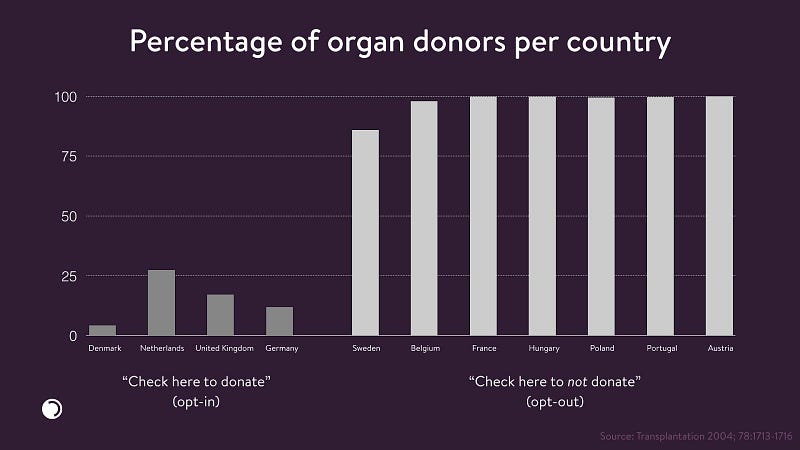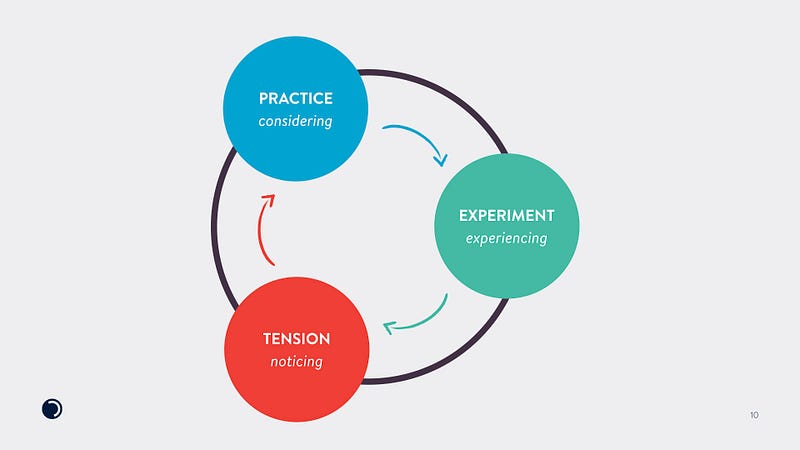How Your Organization Can Make Great Decisions By Default

Photo credits to
First question. What’s the first thing you do when you wake up?
Do you check your phone? Read the news? Make a cup of coffee? Or hit the shower?
Second question. Do you have to tell yourself do that thing? Or do you do it without thinking?
My guess is that you do it without thinking because behaviors we do after waking up happen almost automatically. We check our phone, read the news, make coffee, or hit the shower without even thinking about it.
These automatic behaviors are our defaults.
The power of defaults
Most people think of defaults as the preselected settings in our software or devices. The default font on Microsoft Word is Calibri, size 11. Building thermostats are set to 72 degrees Fahrenheit by default. Default apps on the iPhone include Weather, Health, Calendar, Contacts, and Stocks. Unless we change the settings, the defaults prevail.
Here’s the thing: People have defaults too. Our “defaults” are our preset behaviors and habits that happen almost automatically.
Our default behaviors are shaped by our digital and physical environment more than they are by our own willpower, determination, and good intentions. And if we don’t make conscious choices about the behaviors and habits we want ourselves to do — if we don’t set our own defaults — our environment will set them for us.
Take the 2003 study done by Eric J. Johnson and Daniel Goldstein. They compared countries that had opt-in organ donor policies with countries that had opt-out policies. Countries with opt-in policies asked “Would you like to join the organ donor registry?” while countries with opt-out policies asked “Would you like to refuse to join the organ donor registry?” The number of people who consented to being an organ donor was about 80 percent higher in countries that opted-out than those that opted-in.

Another example comes from Vanguard’s research. From looking at 401(k) participation rates, they found that 92 percent of employees participated in opt-out 401(k) enrollment, while 57 percent participated in opt-in enrollment.
Policymakers and economists recognize that defaults make it easy for people to make decisions they want to make but don’t always follow through on. They also know that defaults make it hard for people to make unwanted decisions.
Now, what if we applied the power of defaults to our organizations?
In large organizations, it might be common to…
Ask someone more senior for permission to make a decision.
Keep computers open in every meeting to answer email.
Create a thorough policy or approval process to prevent future errors.
Make lengthy, comprehensive decks when pitching an idea to senior folks.
Email people to find documents you’re looking for.
We don’t challenge these practices, rules, and behaviors because it’s status quo. “This is just the way it is here.”
But what if your team was constantly challenging the organization’s defaults that aren’t serving them?
What if every team was open to the rest of the organization about defaults they are experimenting with?
What if your organization was intentional about the way they set up their environments so that they nudge people to make the good decisions they want to make?
Constantly experimenting with new defaults is a process. At The Ready, we think of this process as the Change Loop: a three-step continual pattern that enables continuous change.

The first step in the Change Loop is to notice tensions—obstacles in the way of your team/organization doing their best work. Then,consider a list ofdefaults (or practices)to that might address those tensions. From that list of defaults, choose one to two practices to experiment with. Then you’re back to noticing tensions and the loop repeats itself.
This Change Loop challenges the typical big and flashy moves a typical organization does when trying to change. Moves like re-structuring the organization, announcing a completely new strategy, re-doing its entire brand identity, or hiring new executive leaders. However, only attempting big moves is the equivalent of signing up for a marathon when you’ve never ran a mile in your life. It’s an effort that’s doomed to fail.
The Change Loop also challenges the notion that organizational transformation has an end state. “We just need to execute these four phases this year and voila, we’re transformed!” But take the best professional athletes. The best professional athletes don’t think of themselves as “transformed” when they execute a certain amount of phases. They are constantly practicing, learning, and improving, as each improvement increases their motivation to improve even more. I’ve learned that the same goes for great organizations — they are constantly learning, improving their defaults, and evolving. And this state of continual learning and evolving is transformation.
Some defaults we’ve seen work well with teams
Now that we understand the power of defaults, here are three defaults I’ve seen work well with teams we’ve worked with. Know that no default is perfect, and no default makes a team, individual, or organization perfect. Defaults simply offer us a way to continuously improve towards the standard that we aim for.
1) Flip your recurring staff meeting into an Action Meeting.
Most teams have a weekly or bi-weekly “staff meeting.” Certain tendencies take place in this meeting: the manager shares updates to the team and ends up doing most of the participating, there’s a pre-set agenda (usually set by the leader) for the meeting, and the conversation can go in any direction — brainstorming, problem-solving, or making a strategic decision.
I’ve learned that the weekly meeting works well if it has space for team members to get what they need to drive their work forward. This is why we advocate that teams who want to make their weekly meeting better try an Action Meeting. The Action Meeting is designed to create a shared understanding of the status of the team’s projects, address obstacles and opportunities that are most important, and clarify the team’s next steps (and the individuals owning each next step). You can read more about the Action Meeting in our in-depth post about it here.
The Action Meeting meeting has a learning curve, even for teams who are eager and fired up to change the way they meet. It’s more process-oriented than your typical meeting. But from their first to third try, teams feel the positive difference an Action Meeting makes—from increased participation, to less back-and-forth tracking deliverables, to having less meetings because important issues are addressed, to even building better relationships.
2) Shift all of your internal communication from email to a transparent, asynchronous communication tool.
You’ve seen ways email can be a pain. Someone isn’t cc’d on an important conversation and now that person needs to be caught up. Backchannel conversations take place, which leads to a team not being on the same page. Updated versions of documents always get lost. And even though you spend most of your workday on email, the amount of emails in your inbox never seems to disappear.
At The Ready, we’ve seen teams experience a positive shift by moving their internal communication from email to a transparent, asynchronous communication tool like Slack or Microsoft Teams. This shift helps teams immediately experience what it’s like to default to open: to make communicating and working in the open the default behavior. No communication tool is perfect, but tools that are designed to promote transparency get teams to immediately experience what it’s like to work in an open way.
As an example, one experiment team at one of our clients embarked on a mission to make communication and information sharing more transparent in the organization. They were known as the info comms team. The info comms team along with two other experiment teams agreed to do a short experiment of using Slack instead of email for all communication related to the team’s work.
All three teams immediately saw the benefit: focused conversations, easier coordination, and honestly, more fun. They felt the benefit of the shift so much so that the info comms team wanted to invite the entire organization to shift all internal communication from email to Slack. Wow.
So, the team proposed it to the organization. We’d love to try a time-bound experiment: move all internal communication taking to Slack. By doing this, we hypothesize that information and communication will be more transparent in our organization.
The shift to Slack lead to many important changes. A vibrant community and ongoing dialogue formed around the organization’s transformation effort. A #member-feedback channel was created, where anyone could share feedback they heard from their customers. Teams formed on their own to solve problems based on customer feedback. The senior leadership team even made their channel public so that anyone in the organization could read their conversations, ask questions, and chime in.
The organization knew they weren’t trying out a new tool for its own sake. They were clear that this provided a way to make working transparently the default.
3) Do a Closing Round at the end of every meeting.
Closing Rounds are one of the easiest ways to get into the habit of reflecting, learning, and improving. Here’s what you do: dedicate five to ten minutes at the end of every meeting to have everyone share their answer one-by-one to a specific prompt. Prompts like:
“What did you notice about today’s meeting? What did you learn?”
“What went well? What could we do better?”
“What’s your biggest takeaway from today?”
Most well-intentioned teams want to take more time to retrospect. But when the team gets busy, retrospection typically gets de-prioritized. This is why the Closing Round is so powerful: it’s an easy way to get teams to retrospect enough to the point where retrospection becomes a norm. And doing this in every meeting enables teams to continuously improve without even thinking about it.
From here on out, you are a choice designer
Now that you know how powerful defaults are, you are officially a choice designer. As a choice designer, you must observe your team and organization’s current defaults, challenge defaults that don’t make sense, question where there’s room for improvement, and place hurdles on unwanted behaviors. Most importantly, you must constantly search for ways to make it easy for you, your team, and your organization to make great decisions.
Our environment can make our choices for us. But we have the power to design it to make it easier for ourselves, our teams, and our organizations to make better decisions.
Thank you Sam Spurlin, Kendrick Wang, Spencer Pitman, and Willie Tran for the editing feedback.
Credit to Jason Little for his work on the Lean Change Management Cycle—it’s the main inspiration behind our thinking on the Change Loop.
